During the week of November 15, the fourth bore of the Caldecott Tunnel was named for Ellen O’Kane Tauscher, a former Congresswoman for California.
For more about the Caldecott Tunnel, visit our information page.
During the week of November 15, the fourth bore of the Caldecott Tunnel was named for Ellen O’Kane Tauscher, a former Congresswoman for California.
For more about the Caldecott Tunnel, visit our information page.

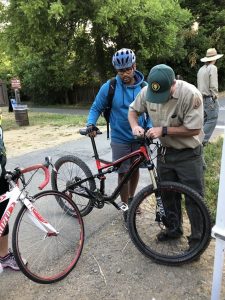
Thousands of East Bay residents pedaled to work on Thursday, May 10 to celebrate the 24th annual Bay Area Bike to Work Day. Morning counts taken at East Bay Energizer Stations tallied 19,800 people either stopping in or rolling by. In Contra Costa alone, over 4,000 riders were counted.
The event’s 48 Energizer Stations were located next to popular bike commute routes, along regional trails, at BART and other transit stations, and in downtown areas around Contra Costa. Volunteers cheered cyclists on by giving away coffee, snacks, and free Bike to Work Day bags.
Free Bike Bells: At the 511 Contra Costa Energizer station in Walnut Creek, the East Bay Regional Park District affixed over 200 free bike bells as part of their “Share Our Trails: Ring or Call Out” trail safety and etiquette program.
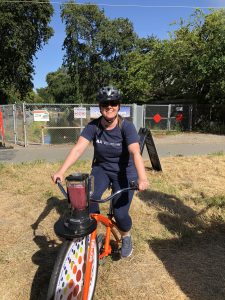
A BTWD Success Story: Sometimes all it takes is one bike commute for people to realize they’d like to bike to work regularly. That’s what happened with K. Myers – she literally started cycling on Bike to Work Day and is now committed to making her commute between Concord and Walnut Creek by bicycle every Thursday to work at AAA. When asked how she would get home in the case of emergency, she said, “Uber, Lyft or GIG if it was available in Walnut Creek.”
Clayton to Concord for a Decade: Steve Biggs has been bike commuting between Clayton and Concord most days for the past 10 years. Although he biked for fitness throughout much of his life, it was only 10 years ago that Bike to Work Day inspired him to try biking to work. This year’s BTWD was his 10th year anniversary as a bike commuter, so he whipped up a bike-blended smoothie on the trail.
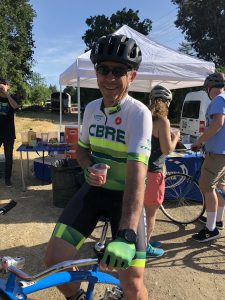
Steve recently bought an e-bike which allowed him to commute in the driving rain this past winter. He discovered that with his e-bike he was able to travel more in step with cars on the road, making him feel safer.
During the summer Steve rides his road bike. He loves cycling to work and to the grocery store. An added bonus from cycling to work is that it has increased his fitness level for his double centuries (200 mi. rides).
Bike to School Events: Bike to Work Day wasn’t just for commuters – local students and teachers joined in the fun with 117 schools hosting Bike to School Day festivities on Thursday and throughout National Bike Month this May.
Participation Up Substantially: Participation in Bike to Work Day has increased 30% over the past five years.
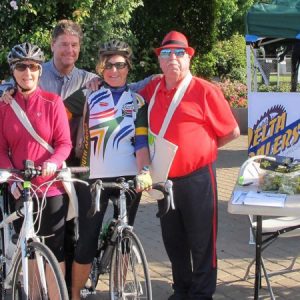
In Brentwood, Mayor Robert Taylor and Brentwood Traffic Engineer, Steve Kersevan, joined the Delta Pedalers Bicycle Club at their City Park Energizer Station.
Longtime Bike to Work Day volunteer Dick Anderson (age 82), who hosted the Martinez Amtrak Energizer Station, had a story to share which seems sums up the ‘people helping people’ spirit behind Energizer Stations:
A young couple got off the last train of the morning commute. They were about to transfer their boxed bikes to an AMTRAK bus to continue their journey. After I presented them with bike bags, Gatorade and bagels they offered to pay me for them. I told her that I do this strictly as a volunteer and I’d never accept any payment anyway.
Since I was ready to pack up for the day, the fellow offered to take the table I borrowed from AMTRAK back for me, saving me the effort.
[facebook https://business.facebook.com/pg/511CC/photos/?tab=album&album_id=10155213567571755 social_plugin=false]

Bay Area traffic is bad. In fact, it’s the second-worst in the nation. So why aren’t more people carpooling? Because carpooling can be difficult. With Scoop, it’s easy.
The Scoop app connects you with commuters traveling in the same direction, building your carpool for you. The app even handles directions and rider-to-driver payments. All you need to do is tell the app where you’re starting from, where you’re headed, and what time you want to leave before the deadline (9pm for the morning commute, 3:30pm for the afternoon) and it does the rest. Plus, your ride home is guaranteed.
Visit 511contracosta.org/scoop for complete details and to download Scoop.

On Monday, May 22nd, Contra Costa County will host a community workshop on the I-680/Treat Boulevard Bicycle and Pedestrian Improvement Plan.
The goal is to identifiy improvements to serve bicyclists and pedestrians using the Treat Boulevard/I-680 corridor between the Iron Horse Trail, through the Interstate-680 (I-680) over-crossing near the Contra Costa Centre/Pleasant Hill BART station area, and extending west to Geary Road/North Main Street in the City of Walnut Creek.
Since the I-680/Treat Blvd overcrossing is one of the main arteries into the Contra Costa Centre/Pleasant Hill BART area from areas of Walnut Creek west of the freeway, residents and commuters are encouraged to attend this meeting and give feedback.
For more information contact: Jamar Stamps, Senior Planner at (925) 674-7832 or jamar.stamps@dcd.cccounty.us
To learn more about this project, please visit: http://www.cccounty.us/680Treat
This weekend, Interstate 80 will be closed in both directions between San Pablo Ave and San Pablo Dam Rd for construction work. The closure will start 11pm Saturday, August 20th and end 7am Sunday, August 21st. Temporary detours will be in effect.
For more information, visit: ccta.net/sanpablodamroad

Overnight on Saturday, June 18, I-80 will be closed in both directions in the Richmond/San Pablo area for construction on the San Pablo Dam Road Interchange. The closure will be between San Pablo Ave and San Pablo Dam Rd and be in effect from 11pm Saturday, June 18 to 7am Sunday, June 19. Temporary detours will be in effect.
For more details on the closure, please visit the San Pablo Dam Road Interchange information page.
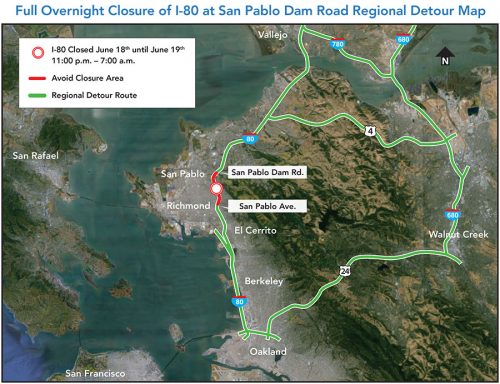
 A redesign for the I-80/San Pablo Dam Road interchange is in the works! The project will add roadway capacity, create a safer crossing for pedestrians and bicyclists, and improve the I-80 ramps at El Portal Drive and McBryde Avenue.
A redesign for the I-80/San Pablo Dam Road interchange is in the works! The project will add roadway capacity, create a safer crossing for pedestrians and bicyclists, and improve the I-80 ramps at El Portal Drive and McBryde Avenue.
The project is a collaboration between the Contra Costa Transportation Authority & City of San Pablo. For more information, click here or watch the video below.

Is getting around West County getting harder? Is traffic on I-80 at every hour of the day getting you down? If you’re interested in providing input to the design of public transportation that works for you, join staff and other citizens at a community workshop to help shape the future of transit in West County.
The West Contra Costa Transportation Advisory Committee (WCCTAC) is hosting a series of community workshops and an online survey to develop realistic public transportation alternatives to driving and commuting on congested roadways. Do you live in Richmond and want an express bus to see your family in Oakland? Do you live in Hercules and want BART to get you into San Francisco on workdays? These are just some of the options being considered, but policy makers need your input to decide which options will move the region one step closer to reality.
If you live, work, or travel anywhere in West County and are interested in expanding your transportation options, WCCTAC wants to hear from you! Attend the workshop closest to you or the one that works best for your schedule (the same information will be provided at each workshop). Attendees will have a chance to win pre-loaded Clipper Cards from 511 Contra Costa!
West County Community Workshops:
Tuesday, April 12
6:30 p.m. to 8:30 p.m.
San Pablo City Council Chambers
13831 San Pablo Avenue, San Pablo
Add to calendar: Google | Outlook | iCal
Wednesday, April 13
6:30 p.m. to 8:30 p.m.
Pinole City Council Chambers
2131 Pear Street, Pinole
Add to calendar: Google | Outlook | iCal
Thursday, April 14
6:30 p.m. to 8:30 p.m.
Richmond City Council Chambers
440 Civic Center Plaza, Richmond
Add to calendar: Google | Outlook | iCal
If you can’t make it to one of the workshops, your option can still be heard. One week before the April meetings, WCCTAC will post a brief survey to learn more about your preferred travel methods and favorite destinations at WestCountyTransitStudy.com. Using your the public’s, WCCTAC will determine which transit options will make it to the next stage. A second round of workshops will be held in the fall to see what the public thinks about the options that were advanced.

The West Contra Costa Transportation Advisory Committee (WCCTAC) and Contra Costa Transportation Authority (CCTA) are holding a joint Telephone Town Hall Call-In Event this Thursday at 6pm to talk about the West County High-Capacity Transit Study and other transportation improvements in West County.
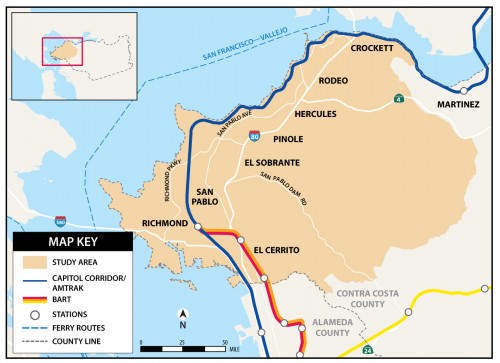 The West County High-Capacity Transit Study is evaluating new public transportation options and funding opportunities to expand alternatives to driving.
The West County High-Capacity Transit Study is evaluating new public transportation options and funding opportunities to expand alternatives to driving.
During the Telephone Town Hall, you’ll learn more about the Study and other planning efforts. Experts will be on the call to answer questions about West County transportation. You’ll also be asked to respond to a few quick polling questions.
West County Telephone Town Hall
Thursday, November 12, 6pm – 7pm
Call in toll-free to 1-877-229-8493
Enter access code 112664 when prompted
The Telephone Town Hall will provide an overview of the Study, but it won’t be the only opportunity to provide input. The first round of public meetings will be held in February 2016, with a second round anticipated in Spring 2016.
For more information on the Telephone Town Hall or the West County High-Capacity Transit Study, visit WCCTAC.org.
 The Contra Costa Transportation Authority (CCTA) is gathering public input to help prioritize what projects and programs should be included in their long-term roadmap for future investments – the Transportation Expenditure Plan (TEP). Giving your input is both easy and fun thanks to the CCTA’s online investment game.
The Contra Costa Transportation Authority (CCTA) is gathering public input to help prioritize what projects and programs should be included in their long-term roadmap for future investments – the Transportation Expenditure Plan (TEP). Giving your input is both easy and fun thanks to the CCTA’s online investment game.
The way the game works is simple: You start with ten ‘coins’ which you spend on the projects most important to you. Projects are grouped by category (e.g. BART, Biking, Highways) and to ‘invest’ in a project, you just drag one (or more) coins into the project’s ‘coin box’:
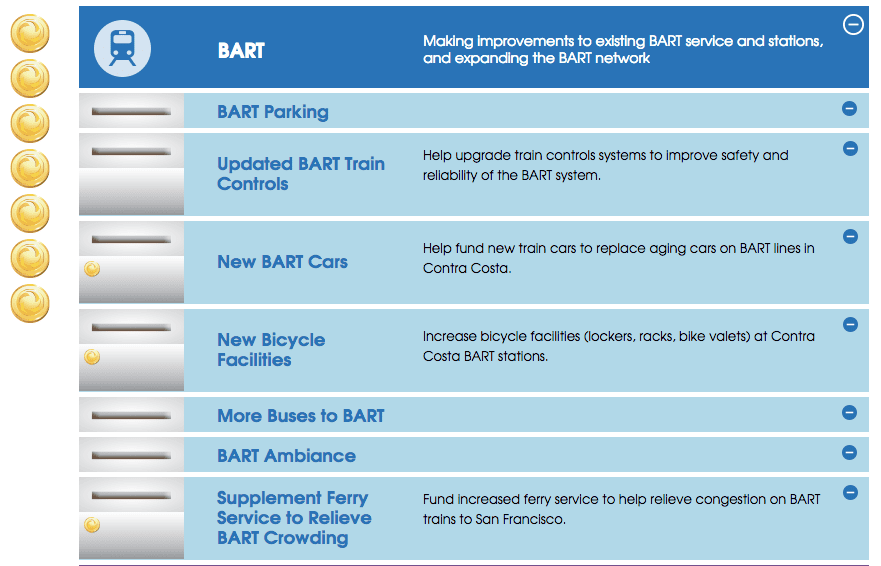
Once you’ve used up all your coins, you can review and submit your investment priorities, as well as share the tool with your friends. Here’s what a completed investment ‘portfolio’ might look like, including the major project categories:

If you’d like to play the game and give your feedback to CCTA, or just want to see which projects have gotten the most support so far, visit keepcontracostamoving.net.


Julie Pierce is a council member for the City of Clayton, chair of the Contra Costa Transportation Authority and president of the Association of Bay Area Governments; she also serves on the Metropolitan Transportation Commission and sits on the Board of TRANSPAC — the Regional Transportation Planning Committee for Central Contra Costa. In addition, Pierce is president of the California Association of Councils of Governments (CALCOG) — the state association for councils of governments, regional transportation planning agencies, transportation authorities and congestion management agencies. CALCOG’s board also includes representatives from the League and California State Association of Counties. For more information, visit www.calcog.org or follow CALCOG on Twitter (@The_CALCOG). This article is courtesy of the Western City Magazine.
I am a city council member, but I am also a regionalist. These are not mutually exclusive titles — each needs the other. Regional governments are built with and depend on the expertise of local officials. Because local government is the level of government closest to the people, we hear firsthand when potholes go unfilled or the garbage is not picked up.
But our residents live in regions. It’s not unusual for someone to make their home in one city but work in a second city, shop in a third and go to a fourth for recreation. Our residents expect their local governments to work together regionally.
Enter SB 375 (Steinberg, Chapter 728, Statutes of 2008), a law that requires a Regional Transportation Plan (RTP) to go beyond existing requirements and meet greenhouse gas emissions reduction targets. Implementing this policy at the regional level made sense to the Legislature because travel patterns could not be addressed on a city-by-city approach; it requires regional cooperation.
SB 375 also recognizes local authority and leverages the symbiotic relationship between local and regional planning. Local plans provide the baseline for all regional plans and investment decisions. Yet at some point, a transportation investment crosses local boundaries: A new bus line is funded, a road is built or a bike lane is created, and the land-use market responds. New homes are built, businesses spring up, and transit and freight routes are altered. Land-use investment drives transportation systems. And transportation investment drives land-use markets.
By the end of April 2015, all 18 metropolitan planning organizations in California will have adopted their first RTPs under SB 375. The San Diego Association of Governments (SANDAG), which was the first to adopt in 2011, will be adopting its second regional transportation plan in summer 2015. So it’s appropriate now to take stock of what SB 375 has — and has not — accomplished.
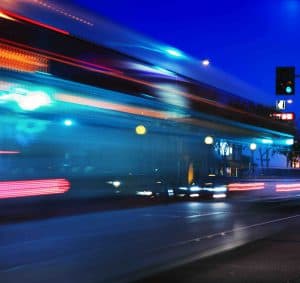 Changing the Conversation. Historians may ultimately conclude that SB 375 was more about conversation change than climate change. SB 375’s real power derives from spotlighting the RTP. In the past, these plans were barely understood by many local officials, much less by the public they represented. But SB 375 brought in stakeholders in a wonderful way. Suddenly, people (such as residents, local business owners, public health advocates, social justice groups and other stakeholders) could talk about the future of the transportation system, spotlighted by the RTP, in the same way they could engage in their local planning processes. This type of transparency and public engagement, which often involves passionate and sometimes conflicting input, can be an intense and challenging process, but it is the cornerstone of democracy and can only be good for our future.
Changing the Conversation. Historians may ultimately conclude that SB 375 was more about conversation change than climate change. SB 375’s real power derives from spotlighting the RTP. In the past, these plans were barely understood by many local officials, much less by the public they represented. But SB 375 brought in stakeholders in a wonderful way. Suddenly, people (such as residents, local business owners, public health advocates, social justice groups and other stakeholders) could talk about the future of the transportation system, spotlighted by the RTP, in the same way they could engage in their local planning processes. This type of transparency and public engagement, which often involves passionate and sometimes conflicting input, can be an intense and challenging process, but it is the cornerstone of democracy and can only be good for our future.
Performance and Trajectory Are Key Measures. SB 375 added a performance metric — greenhouse gas reduction — to transportation funding, but did not say how to achieve that goal. Local and regional governments retain full discretion on how to achieve the goal. (The California Air Resources Board sets reduction targets for each region.) As a result, the appropriate way to review a particular plan is not by determining whether it includes a specific policy or practice but whether the trend line of greenhouse gas reduction and other key indicators for each unique region is improving at an appropriate pace with regard to the target.
Considerations of Fairness and Equity. Part of the conversation change created by SB 375 has been the increased participation of equity groups, such as advocates for disadvantaged communities and social justice. This is an area where we all can still do more. Because transportation and transit are critical elements to household economic independence, it is important to consider all voices in our transportation system. This means including modes and destinations that differ from those used in traditional transportation planning.
Litigation and the California Environmental Quality Act (CEQA). The California Supreme Court is considering whether to review the court of appeal’s decision in the first CEQA case brought against an RTP that includes a greenhouse reduction goal. That case was filed against the San Diego Association of Governments. Another environmental lawsuit has been filed against Merced County Association of Governments, and the Metropolitan Transportation Commission in the San Francisco Bay Area has been the target of four lawsuits from environmentalists and conservative property groups.
Although CEQA lawsuits are not unusual, it is a little unsettling that this costly litigation involves elements of the RTP that may or may not occur. An RTP covers 20 to 35 years. But unlike a General Plan, federal law requires that the RTP be updated every four or five years. As a result, some of the litigation involves assumptions that are made about what may or may not happen in 20 years if all the revenue, population, economic and development assumptions hold true. Think about the events of the past five years that nobody would have predicted 20 years ago, and you get the idea. It’s worth considering whether the value of defending such assumptions under the fair argument standard is a prudent use of funds when each metropolitan planning organization is required to update its plan and conduct a subsequent full environmental impact report every four years.
Funding, Funding, Funding. SB 375 is a good planning law, but it remains an unfunded regional mandate from the state. The costs of increased planning, modeling, public outreach and more environmental analysis have been only partially covered with one-time funds. Regions cobble together funds from a variety of sources — including in some instances dues from member cities and counties — and it’s unclear where the long-term planning funds will come from.
But more importantly, funding for infrastructure is critical if California is going to meet its economic, housing and climate goals. Our infrastructure is crumbling. Our transportation funding has been stagnant. It’s hard to build a new low-carbon system when so much of our current funding must be invested in maintaining what we have.
Our collective challenge as a state is to develop new sources of funding that can rebuild and restore our transportation system. CALCOG supported SB 1077 (DeSaulnier, Chapter 835, Statutes of 2014) to study the viability of a road usage charge in lieu of a gas tax, because this is the type of transformative structure that is needed. I have not, until now, mentioned cap and trade. That is because cap and trade is unlikely to produce enough revenues to facilitate transformative change in neighborhoods statewide. It’s a tool in the toolbox, but not a panacea.
Bottom-Up Regionalism. Finally, let me put my city hat back on. The regional process works only if city and county governments are fully engaged. Ultimately, a regional transportation project does not proceed unless the local governments want it. Many regional entities consider themselves “wholly owned subsidiaries” of their member local governments. Often, regional transportation agencies can provide good regionwide travel data that all member agencies can access and rely on. The agencies also provide an excellent forum for facilitation. But they do not work unless the local officials from the region are willing to collaborate — and work from the ground up. Together we are charged, by our residents and now SB 375, to plan the future of our region for our children and grandchildren’s families. To get that right, we must work together.
CONCLUSION
The future economic prosperity of our regions will be shaped by these regional strategies that expand transportation and housing options while protecting agricultural resources, open space and natural habitats. The plans start by funding long-overdue repairs to infrastructure and then look to the future by:
The regional visions come into focus in our downtowns, main streets and neighborhoods where investments and policies are tailored to the character of our unique communities. The decisions we make today will drive the economic prosperity of our regions tomorrow. It’s a process that requires all of us to be engaged as we shape the future of our cities, regions and state.
ABOUT SB 735
ADDITIONAL RESOURCES
SIX THINGS YOU SHOULD KNOW ABOUT YOUR REGIONAL GOVERNMENT
On March 5, 2015 the Water Emergency Transportation Association (WETA) Board approved the Richmond Ferry Project Agreement, signalling the return of ferry service between San Francisco and Richmond.
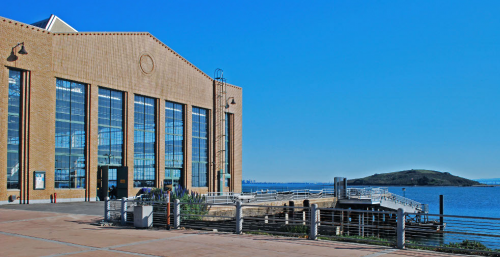
The Water Authority will now order two catamaran ferry vessels — which will become part of the San Francisco Bay Ferry fleet — and build the new ferry terminal at Ford Peninsula in Richmond. According to the Agreement, ferry riders can expect:
The Agreement does not provide for service on weekends, holidays or for San Francisco Giants games. Service is expected to begin sometime in 2018. For 2018, adult fares will be $9.10 one-way, or $6.80 with a Clipper Card. The youth and senior fares will be $4.50 and children under 5 will ride free.
For more information about the Richmond Ferry Project Agreement, click here.
The California Department of Transportation and the Contra Costa Transportation Authority are constructing two new connector ramps, one connecting westbound State Route 4 (SR-4) to northbound SR-160, and one connecting southbound State Route 160 (SR-160) to eastbound SR-4 in Contra Costa County.
Part of this construction work entails adjustment of temporary bridge supports that span over SR-4. In order to ensure crew and public safety during this work, the contractor will close all lanes of SR-4 in the eastbound and westbound directions between the SR-4/SR-160 connector ramp and Laurel Road.
These closures are scheduled to take place on the evenings of February 25, 26, and 27th from 11:59pm to 5:00 am.
The detour for this work will be as follows:
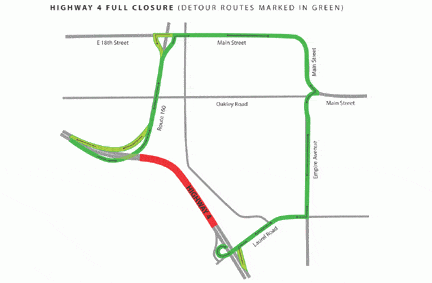
Motorists are advised to expect delays and allow extra time for their commute. Please drive with caution through the detours and leave safe traveling distance between your vehicle and the vehicle ahead of you.
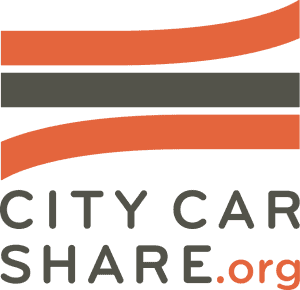 Thanks to a nearly $1 million grant from the Metropolitan Transportation Commission (MTC), carsharing is about to become a reality in both Richmond and El Cerrito.
Thanks to a nearly $1 million grant from the Metropolitan Transportation Commission (MTC), carsharing is about to become a reality in both Richmond and El Cerrito.
The MTC has awarded a $973,864 grant to fund a program called CarShare4All, a collaboration between City CarShare, the Contra Costa Transportation Authority (CCTA) and the Bay Area Climate Collaborative (BACC). The program will deploy vehicles to El Cerrito, Richmond and Oakland, including a wheelchair-accessible van.
“Carsharing is a very important part of our strategy to provide transportation options,” said Kevin Romick, Chair of the Contra Costa Transportation Authority, “This project with City CarShare and the Bay Area Climate Collaborative provides critical links to and from public transit, which provides multi-modal travel choices for Contra Costa residents.”
According to a project factsheet released by Richmond Mayor-elect Tom Butt, beyond bringing carsharing to El Cerrito and Richmond, the CarShare4All program will allow City CarShare to expand access to discounted memberships for low- and moderate-income families and increase the availability of wheelchair-accessible vans to its members.
A date for initial service has not yet been released.
For more information about the program, read the CarShare4All fact sheet (posted by Richmond Mayor-elect Tom Butt) or City CarShare’s press release.
For more information on carsharing in Contra Costa County, visit 511CC’s carsharing page.
The Contra Costa Transportation Authority (CCTA) is updating the Countywide Transportation Plan and they would like to hear your ideas on how to keep Contra Costa moving. CCTA is responsible for maintaining and improving Contra Costa’s transportation system by planning and funding key projects, like the Caldecott Tunnel Fourth Bore, Highway 4 widening, and BART system extensions. The agency also helps maintain local streets, reduce traffic congestion, and make Contra Costa safe for bicyclists and pedestrians all in efforts to get you where you need to go.
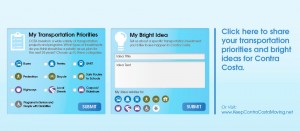
The CCTA in collaboration with Contra Costa municipalities and cities want to know what transportation issues you think are important so they can prioritize where to spend time and resources – BART? Buses? Highways? Local roads? Pedestrian paths? Bicycle routes? Do you have new ideas? You tell them. This is your chance to participate in setting the priorities for our transportation system and suggest your own bright ideas for new projects and programs in Contra Costa. There are many ways you can provide your input:
Attend a public workshop to hear more about the CTP. Here’s a list of the upcoming workshops:
Your opinions and ideas will help shape Contra Costa County’s transportation planning for the next 25 years. Don’t miss this opportunity!
CTP Frequently Asked Questions
English and Spanish Flyer On How To Participate
Caltrans will close Lane #1 of SR-160 in Antioch, in the northbound direction between SR-4 and the 18th Street/Main Street off-ramp on Thursday evening, April 24, from 6:00 pm to 6:00 am. Calrtrans and the Contra Costa Transportation Authority (CCTA) are constructing two new connector ramps, one connecting westbound Highway 4 to northbound SR-160, and one connecting southbound SR-160 to eastbound Highway 4 as part of the Highway 4 improvements.
The Highway 4 projects include improvements that will help revitalize eastern Contra Costa County. The projects expand Highway 4 from four to eight lanes between Loveridge Road and SR-160, add two connector ramps between Highway 4 and Highway 160, and add a BART extension from Pittsburg to Antioch (eBART). This will greatly improve transit accessibility for the region and help reduce traffic congestion and enhance the quality of life for the more than 250,000 residents of eastern Contra Costa County. The projects have been carefully staged to keep 130,000 vehicles per day moving as major construction and demolition work continue, and include over *$1.3 billion in State, Federal, Contra Costa Measure C & J sales tax, regional bridge tolls, and other local funds.


Catching a ride with someone via Lyft, as indicated by the car wearing an iconic pink mustache. Photo credit: lizasperling
Let’s face it, it was only a matter of time.
You have a smart phone, you just got out of a meeting and want to get across town. So you pull out your phone and within minutes someone comes to pick you up. What is this being described? It’s a new breed of carpool apps in action.
Sidecar, and Lyft are two – in a growing field of – smartphone applications that let you, the user, “fill your car’s empty seats with new friends or need to get across town in a hurry” as Sidecar puts it. Its modern, real-time, carpooling.
Apps like Lyft and Sidecar are one more tool – in addition to transit, taxi, walking, cycling – in the toolbox to help one get around town in a snap without having to drive your own car. For drivers, its a way to offset the costs of driving and reduce the environmental impact of your trips.
While Sidecar and Lyft are currently focused in San Francisco, the Contra Costa Transportation Authority (CCTA) is partnering with Sonoma County Transportation Authority (SCTA) and Transportation Authority of Marin (TAM), piloted a similar app called “Real-Time Ridesharing” or RTR.
Interested in learning more? Find out what these apps are all about: read about Sidecar here, Lyft here, and RTR here.
Major interchange improvements at San Pablo Damn Road, McBryde Avenue, and El Portal Drive will ease congestion and improve safety. The public is invtged to attend one of two meetings to learn more about hte project and provide input on the proposed landscaping and aestheic treatment. The two meetings are being offered to promote greater public partipcation.
Wednesday, September 12, 2012 from 6-8 p.m. at Riverside Elementary school 1300 Amador St, San Pablo
Tuesday, September 25, 2012 from 6-8 p.m. at Riverside Elemntary school 1300 Amador St, San Pablo
For more information visit the project website or phone Hisham Noeimi, Contra Costa Transportation Authority Project Manager at 925-256-4731
 Contra Costa Transportation Authority (CCTA) and Caltrans will hold a public workshop at 6:30pm on Thursday, March 22, to discuss the I-680/Norris Canyon High Occupancy Vehicle Ramps Project.
Contra Costa Transportation Authority (CCTA) and Caltrans will hold a public workshop at 6:30pm on Thursday, March 22, to discuss the I-680/Norris Canyon High Occupancy Vehicle Ramps Project.
The workshop represents an opportunity for the community to provide input and feedback during the environmental review process of the $102 million, Measure J project.
The meeting will be in the Foutain Room of the San Ramon Community Center, 12501 Alcosta Boulevard, San Ramon.
For more information check out CCTA’s downloadable notice of the workshop.
Save the Date! The City of San Ramon, Town of Danville, and 511 Contra Costa invite you to attend an informational San Ramon Valley Transportation Summit. The event will be on Monday, May 3, 2010 featuring:
Event Information:
Date: Monday, May 3, 2010
Time: 8:30 AM – 12:00 PM, *Breakfast included*
What: Click here to view a tentative schedule and topics.
Location:
San Ramon Community Center (Terrace Room)
12501 Alcosta Blvd
San Ramon, CA 94583
Continue reading “San Ramon Valley Transportation Summit 2010”
SAVE THE DATE! You and your employees are invited to attend this upcoming Transportation Commuter Fair.
Lamorinda Transportation Commuter Fair
Wed. April 28, 11:30am-1:30pm
Lafayette Library & Learning Center Community Hall
3491 Mt. Diablo Blvd & First Street
The Transportation Commuter Fair will benefit all employers and employees who travel to, through or from Contra Costa County. Lamorinda employers and employees are especially encourage to attend. Visit our booths to learn how to improve your commute.
Stop by to:
Sponsored by 511 Contra Costa in cooperation with the Contra Costa Transportation Authority and the Bay Area Air Quality Management District Transportation Fund for Clean Air.
For more information contact:
Darlene Amaral, Lamorinda 511 Contra Costa Representative
(925) 973-2655
damaral@511contracosta.org
www.511contracosta.org

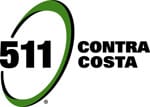



Local News
Bay Area & California News
Did you know 511CC’s on Twitter? To receive these headlines, 511CC promotions, and more, follow @511CC.